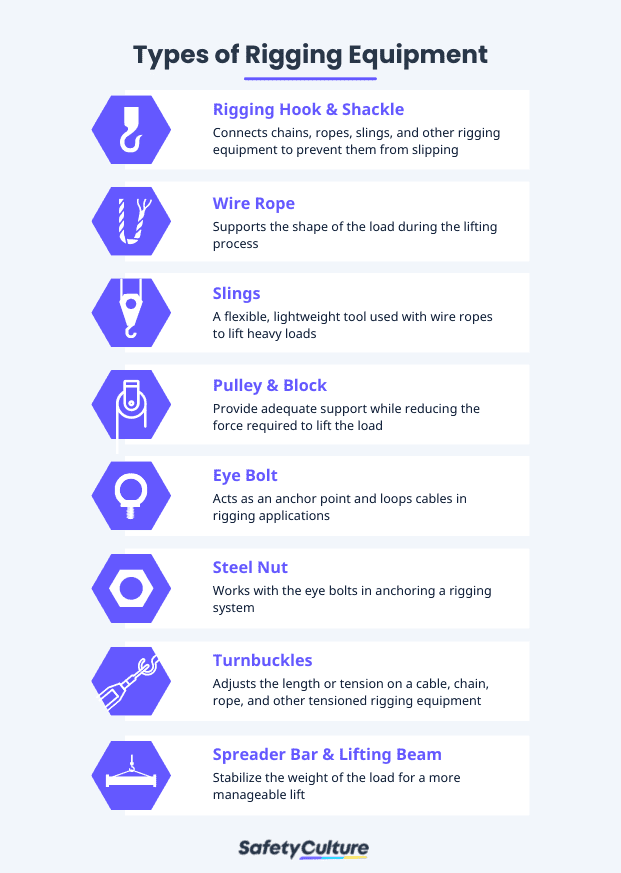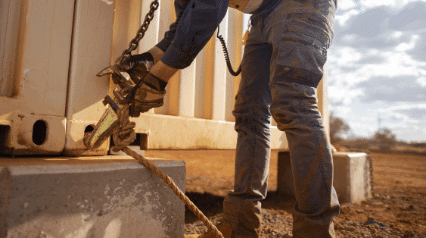What is Rigging Equipment?
Rigging equipment is a set of tools used to hold and distribute heavy loads in the moving process. It securely connects the load to the lifting machines to move objects from one point to another. Industries such as construction, manufacturing, transportation, and event staging often utilize rigging equipment for their operations.
What is the Difference Between Lifting and Rigging?
Lifting and rigging often go hand in hand for a successful heavy construction operation. These two perform slightly different functions on-site. This section discusses how these two differ (and complement) one another.
As mentioned earlier, these two differ in terms of function. Think of them as a continuum. Rigging is responsible for setting things up, while lifting takes care of the hoisting process itself.
In the former portion, riggers set up the equipment needed to assist with lifting heavy loads. They secure the load using different tools and ensure they don’t fall off during the process. After preparing the object, it’s ready to be transported. This part is where lifting comes in. It involves moving and placing materials and people around the site.
Given this, it also means that lifting and rigging require different sets of equipment. For example, rigging equipment includes wire ropes, jacks, bolts, and turnbuckles used with cranes and other hoisting equipment. On the other hand, lifting equipment involves any machine used to hoist and lower loads such as forklifts, boom lifts, overhead cranes, and more.
8 Types of Rigging Equipment (With Examples)

Rigging operations require different sets of tools with varying functions. Knowing what they are and how they function is crucial in ensuring a safe lifting process.
Here are the main types of rigging equipment and their examples:
Rigging Hooks & Shackles
A rigging hook or shackle connects chains, ropes, slings, and other rigging equipment during the moving process. Having a secure hold on heavy loads prevents them from slipping while suspended in the air.
It typically consists of two parts: loop-shaped steel connected to a chain and a safety pin to close it off. Some of the most used rigging hooks include choker hooks, eye hooks, clevis grabs, and sorting hooks.
Selecting the best type of rigging hook to use involves the following set of criteria:
- The weight of the load
- The object to move
- The size of the hook opening (ranges from 5/8 inches to 1 17/32 inches)
- The angle of the hoist
- The connection points from the top and bottom of the hook
Wire Ropes
This equipment supports the shape of the load during the lifting process. It’s often mounted to the crane with hooks, shackles, or swivels to attach and move a load.
Its strength and use vary depending on the following:
- Rope diameter (with 6 x 19 and 6 x 37 as the most popular variants)
- Core material
- Steel grade
- Wire finish (bright steel, galvanized, stainless steel)
According to OSHA 1926.251(c)(4), each rope needs to be one continuous piece without a knot. It shouldn’t include endless rope slings and eye splices at the ends of the wire. Moreover, an eye splice in any rope should only have three full tucks.
Slings
A sling is a flexible, lightweight tool used with wire ropes to lift heavy loads. It provides strength and balance in moving hefty weights around the site. It’s typically made from synthetic material and comes in two types:
- Endless sling – takes an infinite loop shape
- Eye-and-eye sling – contains flat, triangular, or twisted ends made of metal, polyester, or nylon
Pulleys & Blocks
Pulleys and blocks work in tandem to help lift heavy objects without unnecessary force. They provide adequate support while reducing the pressure required to lift the load.
The pulley works by looping a rigging rope to the pulley and attaching it to the object. It holds the rope as it moves the load. It comes in varying sizes depending on the type of frame, rope, and sheave size used.
Meanwhile, the block functions as a stabilizing force, as it carries the rope’s weight during the process. Its most common types include snatch blocks, square blocks, and swivel blocks.
Eye Bolts
This tool acts as an anchor point and loops cables in rigging applications. It comes in various sizes and materials that riggers can choose from depending on their needs. Listed below are the common types of eye bolts:
- Shouldered bolts – used for loading equipment at an angle
- Non-shouldered/straight bolts – used for lifting objects in a vertical system
- Other kinds of bolts – U-bolts, screw eye bolts, and so forth
Choosing the right eye bolt will depend on the following set of criteria:
- Weight of the load
- Type of sling used
- The angle of loading the object (e.g., angular, vertical)
- Frame material for the bolt (e.g., wood, metal)
Steel Nuts
The steel nuts often work with the eye bolts in anchoring a rigging system. They come in different sizes and configurations which are suitable for different kinds of rigging applications. Choosing one will depend on the total weight of the load and the type of thread used (right-hand or left-hand).
Some examples of steel nuts include the following:
- Ball ends
- Dome nuts
- Hex nuts
- Lifting eye nuts
- Wingnuts
Turnbuckles
This tool adjusts the length or tension on a cable, chain, rope, and other tensioned rigging equipment. It has two threaded eye bolts, with one attached to the ends of a small metal frame. Moreover, it comes in two types: a stretching screw and a bottle screw.
Spreader Bars & Lifting Beams
These tools connect the object and the crane while lifting. They stabilize the weight of the load for a more manageable lift. Their use will depend on the type of load that requires support.
When lifting heavy weights, it’s best to use spreader bars. Just as the name implies, this tool spreads the load widely and makes it easier to carry. Meanwhile, lifting beams are more suitable for lighter loads, as they can take all the weight from a single point.
Safety Considerations for Rigging Operations
Safety is paramount to any rigging operation. However, crane and rigging accidents put workers and the property in danger. According to the U.S. Bureau of Labor Statistics, falling objects or equipment comprise more than half of fatal crane injuries from 2011 to 2017.
Thus, it’s crucial to comply with health and safety regulations on handling equipment. The Occupational Safety and Health Administration (OSHA) has established such regulations, including both OSHA 1926.753 (Hoisting and rigging) and OSHA 1926.251 (Rigging equipment for material handling).
Ensure the safety of personnel and property by following these guidelines before, during, and after a rigging operation.
Before the Operation
- Inspect the equipment for appropriate size, style, diameter, length, and thickness.
- Check if the equipment is in good condition.
- Remove defective equipment from the premises.
- Know the manufacturer’s specifications on safe working load and limits.
- Train employees on the proper rigging procedures to follow.
During the Operation
- Operate within the specified load limit of the equipment.
- Follow the rigging charts closely.
- Keep personnel away from the lift area.
- Hoist a few inches and check if the rigging is secure.
- Start and stop the lift slowly.
- Avoid leaving a load suspended on the rig.
- Always keep 10 feet away from power lines.
- Be on guard for obstructions.
- Use proper hand signals when talking to crane operators.
After the Operation
- Move the rigging equipment away from the premises when not in use.
- Store it in a safe compartment to extend its shelf life.
Improve your EHS Management
Cultivate a safe working environment and streamline compliance with our EHS solutions.
Explore nowTips for Maintaining and Operating Rigging Equipment
Even the sturdiest tools can break if not cared for properly. For example, prolonged exposure to harsh environments and heavy-duty operations can cause wear and tear to the rigging equipment.
When operating with rigging equipment, here are a few things to keep in mind:
- Make sure the equipment is in good condition before use. Check for cracks, bends, corrosion, and other signs of strain.
- Follow the manufacturer’s specifications on load weight, angle, center of gravity, and more.
- Operate the tools at their safe working temperatures. For example, synthetic web slings can get damaged if the temperature exceeds 180°F (82.2°C).
It’s also essential to keep them in a safe space after the operations. Maintain the quality and shelf life of rigging tools using these tips:
- Store equipment in a space free from heat, dirt, and moisture. These elements can damage the surface of these tools.
- Keep these tools from getting wet, as they can speed up corrosion. If you’re operating in a damp place, wipe the equipment immediately.
- Try not to drop them after use. Harsh particles can cause friction and wear down the surface.
- Avoid exposing them to sunlight and UV rays, as they can turn dull or faded over time.
Perform Regular Rigging Inspections with SafetyCulture (formerly iAuditor)
Rigging inspections are crucial before operations to ensure that your equipment is safe and in good condition. They also keep your personnel safe from harm. But sometimes, it’s easy to miss certain items when you don’t have a readily available checklist.
Luckily, SafetyCulture is a powerful tool that you can use to perform regular maintenance checks. SafetyCulture takes care of your inspection needs with the following functions:
- Assign a rigger to perform maintenance checks.
- Record the condition of cables, slings, chains, and other rigging equipment.
- Report any rigging equipment malfunction in real-time.
- Resolve equipment issues quickly by raising actions.
- Generate and send reports on your handheld device.
- Keep track of all rigging hardware in your inventory.
- Train employees on proper rigging safety.
- Manage assets needed for work.
- Schedule regular maintenance and inspections easily.




